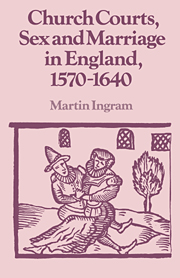Book contents
- Frontmatter
- Contents
- List of tables
- List of maps
- Preface
- Conventions and abbreviations
- Introduction
- PART 1 THE LEGAL AND SOCIAL BACKGROUND
- PART 2 SEX AND MARRIAGE: THE PATTERN OF PROSECUTIONS
- PART 3 CHURCH COURTS AND SOCIETY
- 11 The effectiveness of ecclesiastical justice
- 12 Church courts and society in 1640: retrospect and prospect
- Bibliography
- Index
- Past and Present Publications
12 - Church courts and society in 1640: retrospect and prospect
Published online by Cambridge University Press: 24 September 2009
- Frontmatter
- Contents
- List of tables
- List of maps
- Preface
- Conventions and abbreviations
- Introduction
- PART 1 THE LEGAL AND SOCIAL BACKGROUND
- PART 2 SEX AND MARRIAGE: THE PATTERN OF PROSECUTIONS
- PART 3 CHURCH COURTS AND SOCIETY
- 11 The effectiveness of ecclesiastical justice
- 12 Church courts and society in 1640: retrospect and prospect
- Bibliography
- Index
- Past and Present Publications
Summary
Traditionally the church courts of late Elizabethan and early Stuart England have been condemned as corrupt, inefficient and unpopular. This view, rooted in the partisan judgements of contemporary puritan and common law critics, has in recent decades been undermined by a series of detailed studies of the administration of ecclesiastical justice; yet the myth still lives on. Thus Margaret Stieg, on the basis of a limited and superficial survey of the work of the church courts in the diocese of Bath and Wells in the period 1600–40, confidently reiterates the old clichés. In their relations with the laity, she asserts, the ecclesiastical courts were ‘almost totally ineffectual’, and what little they did achieve was ‘at the expense of great unpopularity’. They were ‘expensive’, ‘venal’, ‘partial’, and hence ‘contemptible’, their activities ‘almost completely pointless’. In brief, she concludes, ‘by the seventeenth century the diocesan courts were anachronisms…dependent upon abandoned premises’.
The aim of this book has been to show conclusively just how misleading such judgements are. None of the derogatory labels conventionally applied to ecclesiastical justice can be accepted without major qualification. Of course the courts had weaknesses, but many of the defects were characteristic of early modern justice in general rather than of the church courts in particular, while the remainder were less acute than has often been supposed. Ecclesiastical justice was neither exceptionally expensive nor unusually dilatory; while evidence of egregious corruption or abnormal partiality is slight.
- Type
- Chapter
- Information
- Church Courts, Sex and Marriage in England, 1570–1640 , pp. 364 - 374Publisher: Cambridge University PressPrint publication year: 1988



